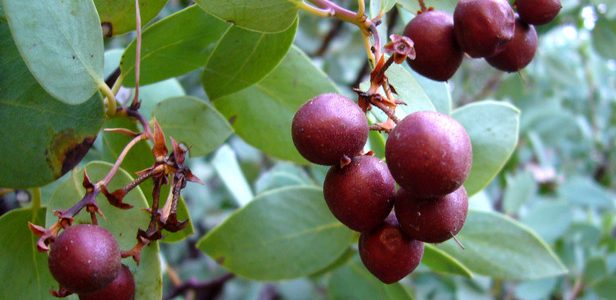
Common manzanita Arctostaphylos manzanita is an excellent representative of the many larger sized species of manzanita. Found in the wild along canyons and slopes in chaparral and oak woodlands of the Northern Coast Ranges, and in yellow pine forest communities of the Sierra Nevada foothills this multi-stemmed beauty is well worth the patience it takes to grow. A mature plant, given enough elbow room, can stand as tall as 15-20 feet high by 20 feet wide. Multiple stems form a dramatic open branch structure. Over time, the main stems become slightly twisted in their up and outward growth. Cinnamon red bark is smooth and cool to the touch. The deep red brown outer bark peels off every year around the summer solstice, revealing a new lighter bark layer which slowly darkens though the year. The almost bare larger stems or trunks branch out towards a twiggy canopy. Smaller branchlets hold vertically oriented tough, waxy, egg shaped leaves rounding to a pointy tip. Flower buds form 4 to 6 months prior to bloom time, waiting patiently on branch tips. Common manzanita blooms December through February depending upon elevation and climate. Tiny upside down urn shaped white/pink florets are an important nectar and pollen source for late winter and early spring bees. Flower nectar is also a key energy source for our residential hummingbirds. True to its name, the fruit of the manzanita (in Spanish, little apple) look like miniature green apples turning red-brown.
Manzanitas are classified in the heath family (Ericaceae). The plants from this family are usually adapted to either arid or waterlogged soils, often living in extreme environments. As a way to mitigate extreme growing conditions many in the heath family share a symbiotic relationship with beneficial soil fungi or mycorrhizae. The California Floristic Province is home to all but one of the 95 different species and subspecies of manzanita. This is due in no small part to California’s crazy quilt geology and its myriad microclimates. The common manzanita alone is divided into six subspecies. Favorites include whiteleaf (Arctostaphylos manzanita subspecies glaucescens) noted for its white grey leaves appearing in contrast within a stand of the shiny emerald green leaved common manzanita (A. manzanita subspecies manzanita). Contra Costa manzanita (A. manzanita subspecies laevigata) is a rare plant, found in only a few spots including Mt. Diablo. White leaf, common and Contra Costa manzanita can each be used as a focal point or small tree substitute in any sunny well drained Bay Area garden. Unlike many of the wild manzanitas adapted to grow in only one particular place, common manzanita is amenable to grow in landscaped areas and dry gardens. It grows best in full sun, tolerating a range of soil types providing there is good drainage and no summer water once the plant has established.
Getting to know the ecology of this native icon and its cousins, provides insight into appropriateness for your particular garden site as well as how our garden choices fit into the wider world. Being a transplant here from the eastern side of our continent, my first encounter with manzanita came before I began learning about and coming to love California’s wild diversity. Out exploring on a friend’s back 40 many years ago, I got entangled in a thicket of cool hard vertically entwined stems. That stand of manzanita jailed me long enough to feel a tiny bit panicked. After a long interlude of squeezing between, climbing under and over I was finally spit out the other-side of a thicket so dense that I could have more easily walked on the canopy. I later came to know that the chaparral plant community is characterized by almost impenetrable scrub-land composed of mainly evergreen hard-leaved shrubs averaging 10 feet in height and adapted to a natural cycle of wild fires. Manzanitas often dominate chaparral plant communities estimated to cover roughly 9% of the CA landscape.
Manzanitas are adapted to wild fire using two different strategies for regeneration. One third of all manzanitas are known as facultative seeders and can regenerate after a fire by either re-growing from a root burl or sprouting a new individual from seed. The burl is a (not always obvious) woody root crown loaded with dormant buds. After a fire and a bit of rain, dormant buds grow new stems on surviving burls allowing the individual plant to live on. Re-sprouting individuals can be up to 200 years old. The remainder of the manzanitas cope with fire by producing seeds that can lay dormant for long periods and are stimulated to germinate and grow quickly after a fire. These manzanitas are called obligate seeders. Wildfires kill mature obligate seeding plants, but new individuals sprout from seed buried in the soil. The buried seed is stimulated to begin germination by heat, smoke and then a few months later, rain. Seeds from the little apples are dispersed by burrowing mammals and ants burying the seed and inadvertently protecting the seed embryo from being desiccated during a wild fire event.
I guess we are all waiting for that gratifying moment after a scorched earth event when the new green sprouts of regenerating life begin to appear.
Happy New Year!
Written by Kristen Hopper
Photo by Zoya Akulova
References:
The Field Guide to Manzanitas, Michael Kaufmann, Tom Parker and Michael Vasey. 2015, Back country Press Recommended if you are inclined to figure out which wild manzanitas grow in your neck of the chaparral. The authors provide regional keys, reducing the number of possible choices by location. The shorter lists of possibilities and use of accessible language make figuring out which species you are looking at a less daunting challenge.
Secrets of the Oak Woodlands, Kate Marianchild. 2014, Heyday.
Introduction to California Plant Life, Robert Ornduff, 1974, UC Press.
Calscape, Wikipedia